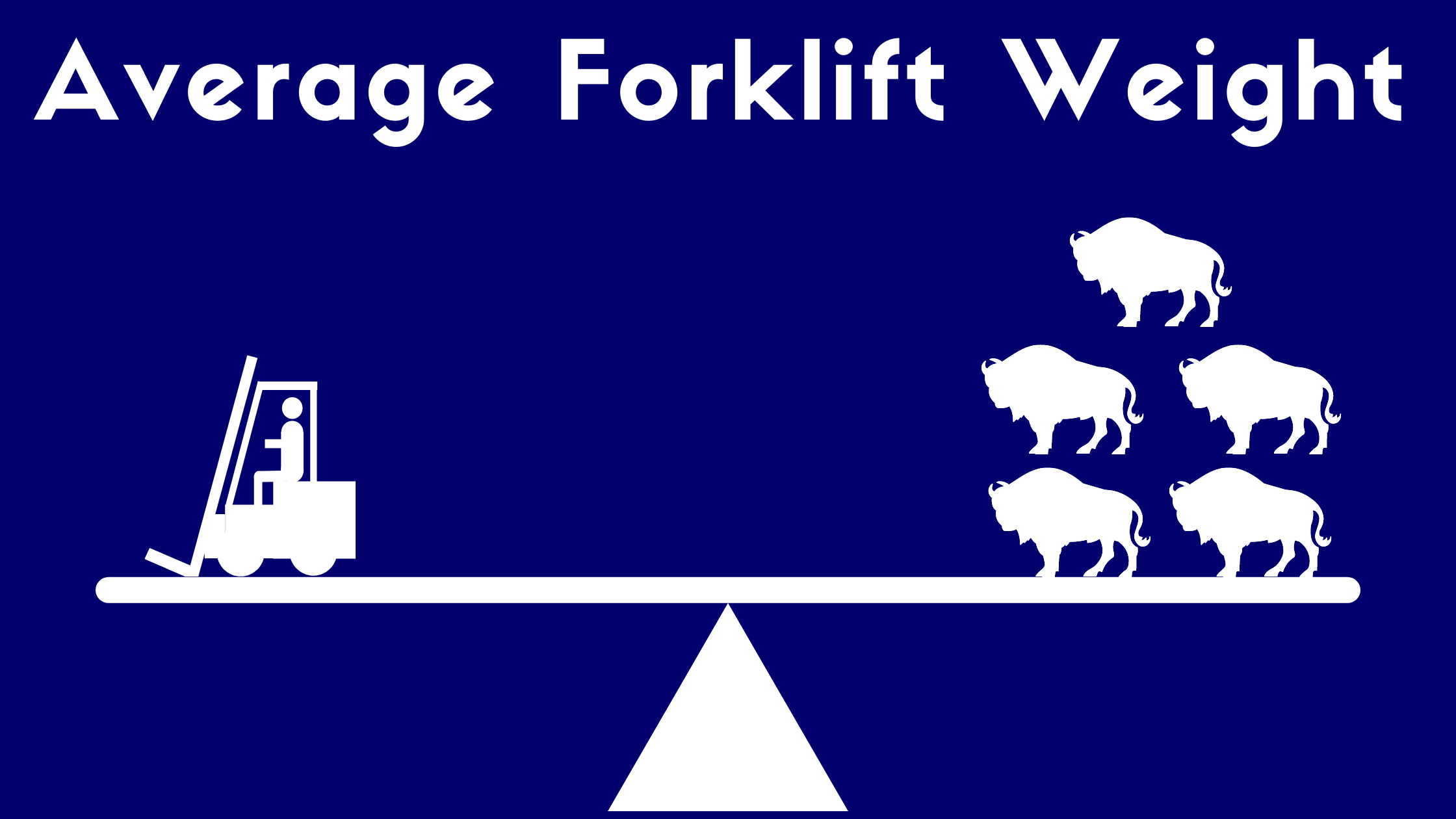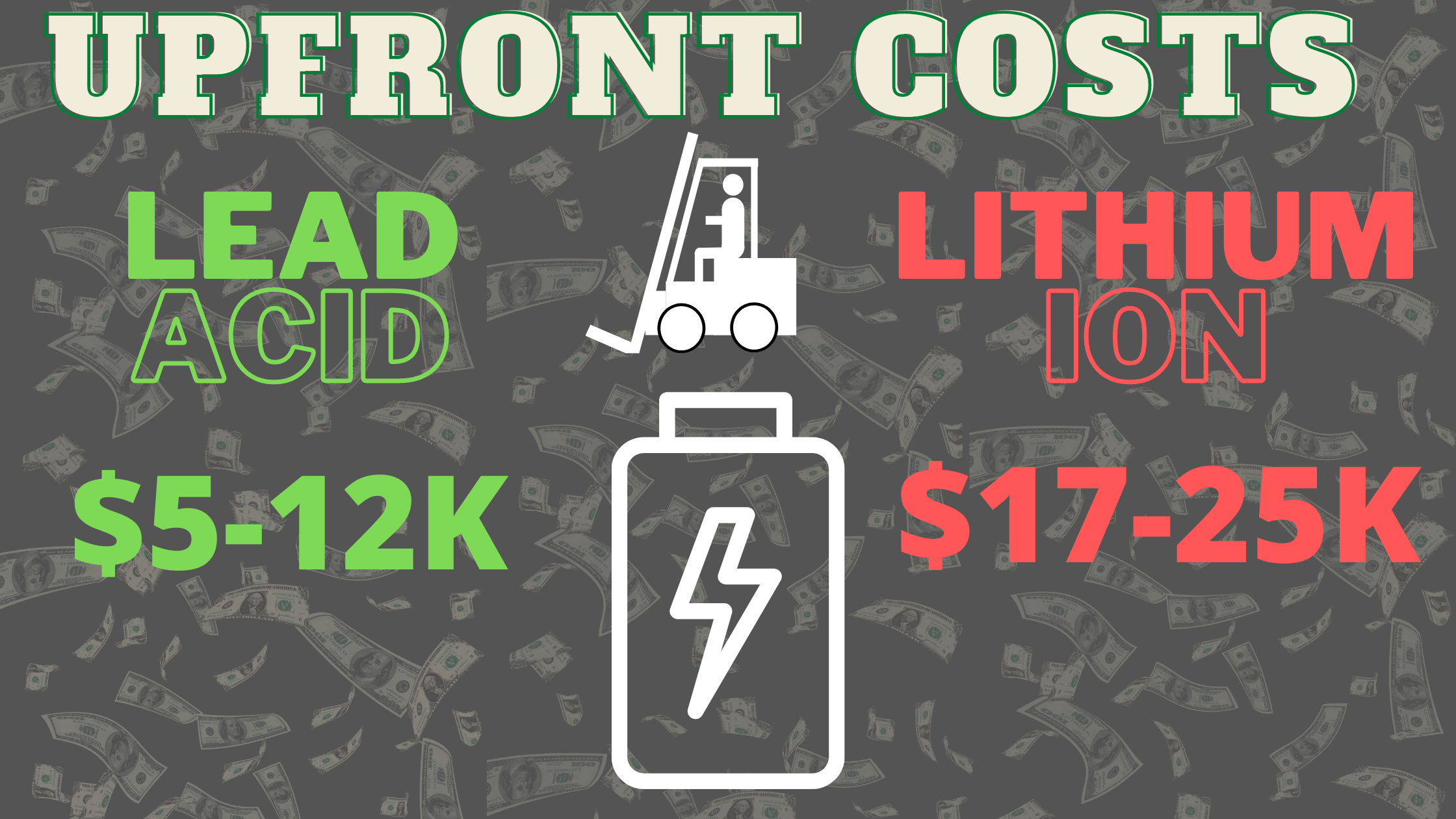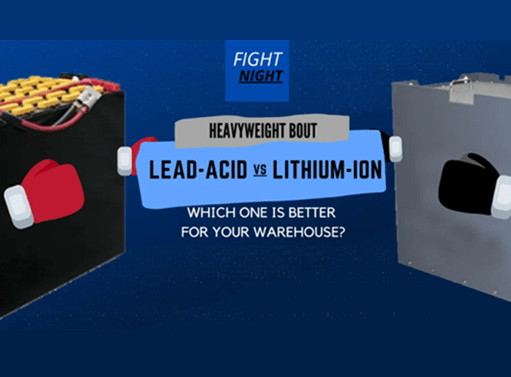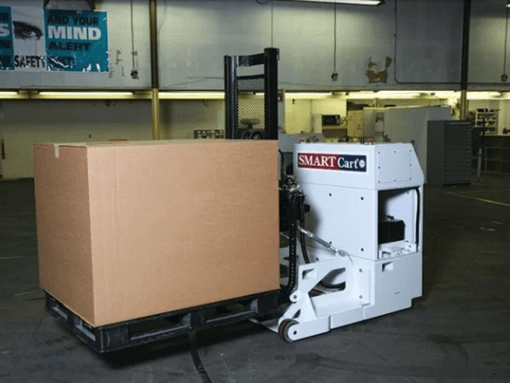Did you know the very first commercial lithium-ion battery was used in 1991?
However, when it comes to forklifts lithium-ion batteries have only been around for 12 years.
Lead acid is the ole reliable, dating all the way back to the early 1920s.
While they are older than you, lead acid batteries have had loads of updates over the years and are still a very sound option for certain applications, as you’ll see below.
So let’s get right to it…

What are Lead-Acid Forklift Batteries?
Lead-Acid forklift batteries are rechargeable batteries that have a high power-to-weight ratio and are sought after due to their lower cost.
They are known as motive batteries, AKA the motor of the vehicle.
What most people don’t think of is the sheer size and weight of lead-acid batteries.
The common car battery weighs about 40 lbs on average but a forklift battery can be between 800 to 4,000 lbs.
In total a forklift weighs 9,000 lbs on average. That is the equivalent of 5 average-sized buffalo.

Despite this, one of the benefits of the lead-acid battery is actually its weight.
Forklifts lift heavy objects (sometimes as much as 36,000 lbs.) hundreds of feet high, so they need something to help balance the weight.
In this case, the battery acts as a counterbalance and keeps the forklift from tipping over when lifting heavy loads.
What are Lithium-Ion Forklift Batteries?
Lithium-Ion forklift batteries are rechargeable lithium and graphite batteries with a very high energy density, low discharge rate and no memory loss.
While lithium is a much lighter material, these batteries still require either a bodybuilder or a machine to move, weighing between 500 to 2,500 lbs.
This lighter battery means less weight that your forklift is carrying, so sometimes you’ll even see a metal plate to help provide additional weight to keep the forklift from tilting when carrying heavy loads.
There are some pros and cons to each of these battery types, but we’ll look at the major areas to help you come to a conclusion on which is best for your application.
In this 4 round heavy-weight fight we will look at maintenance, charging, energy usage and most important, upfront cost.
Let’s have a clean and fair fight, Round one…. take it away Bruce Buffer!

Maintenance
Lead-Acid Batteries
To keep it short and simple — lead-acid batteries require more maintenance.
Now the longer version is that lead-acid batteries require watering.
Just like taking care of your garden you gotta do the same with these batteries.
What happens is water fills the individual cells in your battery to provide a functional level of chemicals and electrolytes that will produce power.
Doesn’t sound too bad right?
Wrong!
Even if you run a one-shift application your batteries will probably need watered once a week or at the very least bi-weekly. And this requires special equipment and the right level of care, because you water too much or too little and you’ll damage your battery.
So typically this labor will be performed by a material handling company/forklift dealer at an hourly rate.
Other maintenance steps to take are:
- Service semi-annually to control acid and corrosion
- Inspect for any defects
- Keep electrolyte level above separator protectors
- Keep the vent caps on tight
Lithium-Ion Batteries
Almost none. Lithium-ion batteries save you thousands because they do not require the most expensive maintenance piece… watering.
However, there are a few things you should make sure to check on every so often. These are listed below.
- Check wear plugs & cables
- Monitor charger for fault conditions
- Make sure your software is up to date
- Keep your batteries at room temperature
- Allow partial discharges and avoid letting the battery die, it is best to charge when you’re around 15-25% of battery left
- Keep away from moisture
Round 1 Winner: Lithium-Ion
Charging
Lead-Acid Batteries
If you take great care of your battery you will get about 1,500 charge cycles. Let me repeat that… GREAT CARE.
This equates to about 5 years if you charge the battery once per day.
Of course, this is the over optimistic side because who doesn’t appreciate a half glass full person in your corner?
But, if we are going to be more realistic, you should expect about 3.5 years of life.
That isn’t too bad, but the problem arises when you have a 2 or 3-shift application.
In these cases you will need at least two batteries per truck because charge time will take 8 hours and then you will need a cool down time of 8 hours as well.
You can get a better picture in the chart below.
| LEAD-ACID | LITHIUM-ION | |
|---|---|---|
| Use Time | 8 Hours | 8 Hours |
| Charge Time | 8 Hours | 1-4 Hours |
| Cool Time | 8 Hours | 0 Hours |
| Total Time Needed Before Use | 16 Hours | 1-4 Hours |
Lithium-Ion Batteries
As you can see above lithium-ion can be 4-16x more effective when it comes to charging production.
But, what about degradation?
You can put a checkmark next to lithium-ion on this one as well.
Lithium-ion batteries generally last about 2,000 – 3,000 cycles. Which is almost double of what you can expect with a lead-acid battery.
This point goes to lithium-ion.
Round 2 Winner: Lithium-Ion
Energy Usage
Wouldn’t you like to save money on your monthly electric bill?
Well that’s what we’re looking at here, finding the battery that is more efficient *cough, cough* cheaper on utilities.
Lead-Acid Batteries
According to the always trustworthy Wikipedia, the energy density of a lead acid battery is 80-90 Wh/L with a specific energy of 35-40 Wh/kg.
All that seems confusing, but all it means is the measure of how much energy is stored in the battery.
Another fun fact for you, lead-acid batteries are not good at keeping their energy. They lose amps while moving, charging, lifting and idling.
Meaning, as a shift carries on the forklift will become weaker and weaker as the battery level goes down, so you might be able to lift 3,500 lbs 186″ at the beginning of a shift but at hour 4 you might only be able to lift 2,600 lbs 186″.
Lithium-Ion Batteries
The energy density of a lithium-ion battery is 100-265 Wh/kg.
That is 3-6 times stronger than lead-acid.
The other big kicker here, lithium-ion batteries keep a constant voltage level during their discharge cycle. This can equal 50% savings in energy compared to lead-acid.
One final point to add is that charging a lithium-ion battery can be done without removing the battery from the forklift.
Unlike the lead-acid batteries, lithium-ion gives users the chance to use opportunity charging between shifts or even during break time.
This is a huge advantage because now you do not need a second battery and your charging space will be just that, a charging space.
Typically with lead-acid you will need a space dedicated for storing your extra batteries while they charge.
This is a major advantage because now you can take that dedicated charging space and restructure it to be additional storage space.
Round 3 Winner: Lithium-Ion

Upfront Cost
Lead-Acid Batteries
Lead-acid batteries will cost you about $5,000-12,000 brand new depending on your size and specs.
The articles below are detailed on electric forklifts (class 1), reach trucks and order pickers (class 2) and pallet jacks, pallet stackers and tow tractors (class 3) and go into a little further detail on the battery costs for each model type. I wrote them so I promise you they aren’t too awful.
- Read About Class 1 Forklift
- View the Complete Overview of Class 2 Forklifts
- Find out the Basics on Class 3 Forklifts
Lithium-Ion Batteries
On average you can expect to spend $17,000-25,000 on a lithium-ion forklift battery.
Now, before you completely write of lithium, consider the added perks from above and make sure to look at the final conclusion below.
Round 4 Winner: Lead-Acid
Conclusion
The easy answer is lithium-ion is the better, more reliable, more efficient, and bigger bang for your buck option.
However, this is only an obvious choice if you are running a 2-3 shift application with a few forklifts.
If you have a warehouse with only a couple of forklifts and pallet jacks that are not used around the clock then you may be better off using lead-acid.
Lithium-ion batteries take the W when it comes to maintenance, charge rate, charging capacity, degradation, lifespan, safety and overall ROI. However, lead-acid batteries are much cheaper and if they are only used intermittently, then they are probably the better option for you.
When to Add Water to a Forklift Battery?
The best time to water your batteries is right before a shift, after the batteries have had time to cool down.
How Long do Forklift Batteries Last?
Lead-acid batteries will last 1,500 charging hours if maintained well. Lithium-ion batteries will last 2,000 to 3,000 charging hours.
Do Propane Forklifts Have Batteries?
Yes, propane forklifts have batteries. However, unlike electric forklifts the purpose of the battery on propane forklifts is not to produce power, it is to help start the forklift.
How Much Does a Forklift Battery Weigh?
A forklift battery weighs between 800 to 4,000 lbs. depending on the type (lithium-ion vs lead-acid) and size (24V, 36V, 48V).






